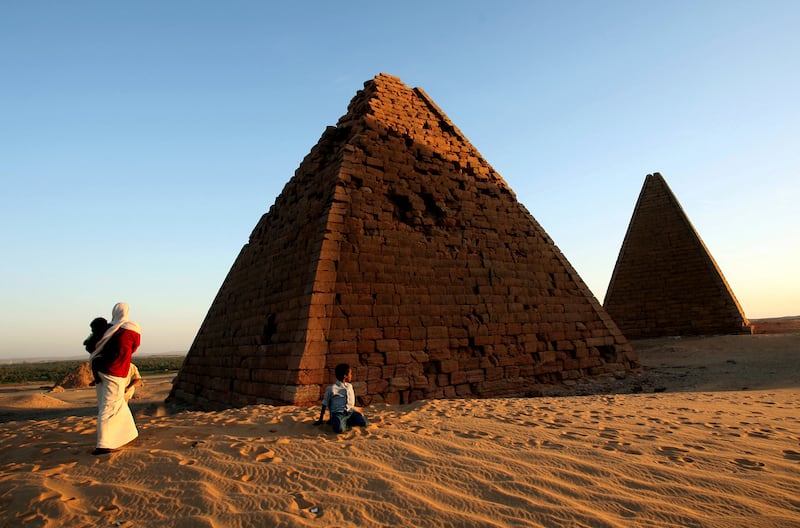Sudan’s rich heritage needs to be respected and protected amid the country’s devastating war, according to an appeal from a group representing Sudanese archaeologists, librarians, historians and associated volunteers.
The initiative is trying to develop, maintain, support and train “an extensive network of contacts and volunteers dedicated to the effective safeguarding of cultural heritage in Sudan”. The groups are working together to protect what they can while collecting information about what has already been destroyed.
In its first report, released last month, the Sudan Heritage Protection Initiative (SHPI), which is part of the non-governmental organisation Heritage for Peace, detailed what it has documented about the scale of destruction so far, with at least 28 cultural and archaeological sites affected.
Damage or destruction in Khartoum reportedly includes the loss of a rare collection of plants and specimens of species extinct in Sudan at the National History Museum; the destruction of the library and archive collection of the Mohamed Omer Bashir Centre for Sudanese Studies at Omdurman Ahlia University; and the destruction of the old market of Omdurman, which was consumed by a fire.
READ MORE
In Darfur, the Performing Arts Theatre in El Geneina was reportedly burned down, while at least three museums suffered damage from shelling, bombing and projectiles.
In Khartoum, there are reports of “extensive damages, vandalism, fire, shelling and looting of universities and colleges”, the report says, naming 15 institutions affected. “The university libraries, archives and research facilities at these institutions have either been lost or are at significant risk of loss,” says the report.
Looting and theft at all sites is a notable risk in war, according to the report. Various sites are also being occupied by fighting forces, making them potential targets.
“We wanted to [lend] support,” said Isber Sabrine, the president of Heritage for Peace, who spoke on the phone from Barcelona. He said that as a Syrian he had experience working on heritage protection during Syria’s war. “What we are trying is to raise awareness … We work in Syria, in Yemen, in Sudan, in Ukraine now.”
In Sudan, the group has been gathering information from sources on the ground, as well as monitoring social media, but “the situation is very complicated,” particularly in Khartoum and Darfur. “There are places where we still don’t know what has happened … We expect that the destruction is more.”
In a statement in May, Unesco said it wanted to reiterate the obligations of states “under the 1954 Hague Convention for the Protection of Cultural Property in the Event of Armed Conflict, which Sudan has ratified, to refrain from damaging or destroying cultural property. It condemn[s] attacks against and damage to cultural heritage in all its forms, attacks against cultural professionals and artistic freedom, and any looting of museums and cultural institutions.”
Sabrine said the situation in Sudan was particularly complicated because “it’s the government itself … destroying cultural heritage,” which raises specific challenges in terms of international law and pushing for accountability.
He said the Sudanese military seemed to have no awareness that “the destruction of heritage is a crime against humanity”.
Anyone involved in peace negotiations should be making sure that all parties to the conflict are aware of the importance of protecting cultural heritage, Sabrine said.
In the meantime, Sudanese volunteers are trying to figure out ways to provide protection, but this is difficult without a lasting ceasefire. Throughout everything, civil society needs to be supported and empowered, Sabrine said.
The war in Sudan erupted on April 15th, with fighting between the Sudanese military, led by Abdel Fattah al-Burhan, and the Rapid Support Forces paramilitary group, led by Mohamed Hamdan Dagalo, also known as Hemedti.
The latest figures released by the UN’s International Organisation for Migration say 2.6 million people have been displaced inside the country as a result of the conflict, while more than 750,000 people have crossed into neighbouring countries – particularly Sudan, Egypt and South Sudan.

Sudan, a north African country of roughly 47 million people, has an ancient and rich cultural heritage. It is home to two Unesco world heritage sites: Jebel Barkal, a sacred mountain and sandstone outcrop; and Meroe Island, which was the heartland of the kingdom of Kush. Tourists used to visit Sudan’s pyramids, and while foreign archaeologists have been travelling and exploring there for a long time, the country was seeing a growing number of young, often female, Sudanese archaeologists who wanted to take charge of their own history.
Last year, Eglal el-Malik, the director of conservation at the government’s National Corporation for Antiquities and Museums, spoke publicly about how the country was seeking the return of artefacts taken from them by British colonisers unlawfully. At the time, the national museum in central Khartoum was being refurbished with a grant of almost €1 million from the Italian government. The museum held more than 100,000 items, including pottery, statues, murals and some of the world’s oldest mummies, said to date from 2,500 BC.
The Sudanese National Museum’s director has since reportedly fled to Europe. Videos shared on social media appear to have shown Rapid Support Forces fighters opening storage containers in the museum’s bioarchaeology lab, which had been recently redone with help from the British Museum.
Describing Sudan’s “unique heritage”, Sabrine said: “It’s very ancient and very diverse … They have a lot of ethnic groups, local languages. Sudan also is very important for Christianity in Africa, it was one of the first places [where] Christianity arrived.”

He said Sudan’s museums include “artefacts which represent different cultures and different civilisations”. Many archives and libraries, “places that are very important for the memory of Sudan, are also in danger”.
Sabrine said as well as “tangible” heritage, there was also “huge, important intangible heritage. All of the ethnic groups, their traditions, languages.”
“We need more international attention … We need more attention from the world. When the war started in Ukraine, everyone was looking to Ukraine and wanted to help. But now with Sudan, that is not happening, and this makes the world [feel] really very unjust.”
“I’m not talking about just cultural heritage, I’m talking about the humans,” Sabrine continued. “We need more journalists to talk about Sudan. We need more reports.
“Our work is also trying to highlight the humanitarian needs. We have a lot of colleagues from the heritage sector in Sudan who are suffering from the consequences of the conflict, they need humanitarian aid. So even the heritage protection efforts as well should aim to support the humanitarian situation.”






















